It runs from October to January next year.
It runs from October to January next year.
Great news for Middleton’s heritage – the Government and English Heritage have listed the Independent Labour Party Club on Milton Street as Grade II. This followed the submission of a scheme to convert it into flats. The listing specifically protects the inside as well as the outside of the building as being of special historic and architectural interest.
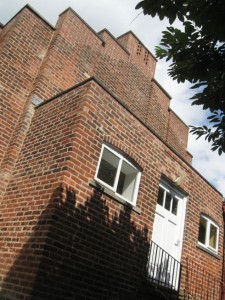 We are grateful to English Heritage for assessing the building in such a short time and to Nick Baker for such great photos..
We are grateful to English Heritage for assessing the building in such a short time and to Nick Baker for such great photos..
Another building of Midddleton’s Golden Cluster receives official recognition. We look forward to sensitive proposals to secure its future for the long term.
Here are the English Heritage listing documents, hot off the press…
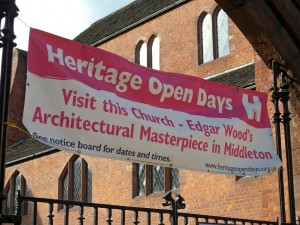 Golden Cluster Month has had another successful year with hundreds of people enjoying four heritage buildings open to the public and various events laid on.
Golden Cluster Month has had another successful year with hundreds of people enjoying four heritage buildings open to the public and various events laid on.
Things were brought to a close by Middleton Heritage Film Group’s ‘Enlightenment Middleton’ film, directed by Anthony Dolan. Over 80 people came to the premiere. This is a great documentary which brings to life Enlightenment heroes, Ashton Lever, George Cayley and Sam Bamford and Middleton’s unique Palladian house, Alkrington Hall. The film will shortly be uploaded to YouTube… we’ll let you know when it does.
Many thanks to all who made September ‘golden’ for Middleton’s heritage!
A new social enterprise may be formed to help save Edgar Wood’s Arts & Crafts Church at Long Street.
Christine Grime, Lee Wolf, Nick Baker and David Morris, two Middletonians and two ‘Wood-ies’ from further afield, have temporarily called it Arts & Crafts Awakening while they consult local people and visitors on the best way forward.
For years many have been almost ‘asleep’ to how special Edgar Wood’s buildings make Middleton. Arts & Crafts Awakening refers to Middletonians now ‘waking up’ to their wonderful Arts & Crafts heritage, not least to secure the future of Long Street Methodist Church and School, the finest in England.
What does the future hold for this Arts & Craft Church? If you have more time, let us know what you think by completing this short survey .
Middleton Heritage Film Group have worked all year on their fourth film about Middleton’s impressive heritage. Don’t miss the premiere coming up next Tuesday! Admission is free, thanks to money from the Heritage Lottery funded Edgar Wood and Middleton Heritage Initiative.
Enlightenment Middleton covers the area’s history of the 1700s and early 1800s. You will be surprised about the Middleton people of that time and what they achieved, a few of them gaining national and international fame for their outstanding lives.

Middleton’s Milton Street Family Centre was closed and sold a few years ago but not before it was lovingly restored by Middleton Township and Rochdale Council’s building repairs team.
New owners want to convert it into ten flats, something which would destroy the interior spaces, replace the lovely windows and install rooflights into the prominent Westmorland slate roof facing the road. The planning application is being considered by Rochdale Council planners and public comments can be seen and made here (the plans can be viewed also). Rochdale Council Conservation section comments have yet to be posted online.
The family centre was for a long time a nursery and before that it was Middleton’s Independent Labour Party Club House and HQ, built in 1912. Furthermore, it was designed by Edgar Wood in a very early Art Deco style. It is completely unique in England and an important monument to the growth of the Labour Movement in Middleton and Manchester. Here is an expert report on the building carried out by the Middleton Edgar Wood project Independent Labour Party Clubhouse, Middleton HBR aug 2014
We all want to see this fantastic monument in the conservation area reused but the current proposals need modifying to prevent irreversible harm to part of Middleton’s unique Golden Cluster of heritage buildings.
This was a day trip organised by the Friends of The Edgar Wood Centre in Middleton to see some Arts & Crafts highlights. We all met at the Arts and Crafts Church and boarded a coach bound for the mecca for northern Arts & Crafts… The lake District.
 Our first stop was at Staveley Parish Church to view the magnificent East window designed and built by William Morris and Edward Burne-Jones (the photo is just one small pane).
Our first stop was at Staveley Parish Church to view the magnificent East window designed and built by William Morris and Edward Burne-Jones (the photo is just one small pane).
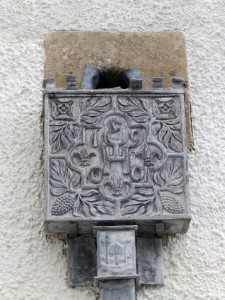
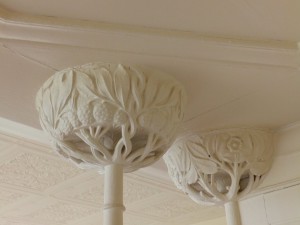
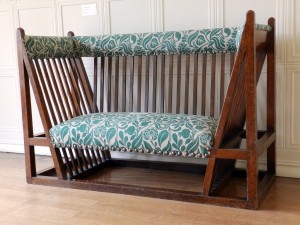 We then travelled to the highlight of our trip, Blackwell, Windermere built between 1898 and 1900, a masterpiece designed by Mackay Hugh Baillie Scott. With a rather chequered history it has somehow managed to retain many of its original features and is considered to be the best example of its type open to the public.
We then travelled to the highlight of our trip, Blackwell, Windermere built between 1898 and 1900, a masterpiece designed by Mackay Hugh Baillie Scott. With a rather chequered history it has somehow managed to retain many of its original features and is considered to be the best example of its type open to the public.
After a brief introduction from a local guide we enjoyed a light lunch before wandering at will to admire the very fine craftsmanship not only of the building but also the contents. Built as a holiday home for Sir Edward Holt, a brewing magnate it has magnificent views over the lake.
Our next stop was at Broad Leys now the headquarters of the Windermere Motor Boat Racing Club but designed by Charles FA Voysey as a large house, again in the Arts & Crafts style.
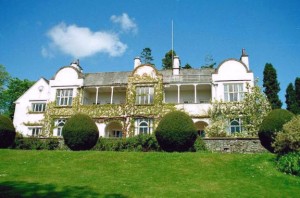 Finally we enjoyed a walk round the gardens and refreshments at Brockhall Visitor Centre (below) although none of us ventured onto the aerial walkways and runway. Comments like ‘It’s too busy’, ‘I’m not prepared to queue’, ‘We haven’t got time’ were uttered at regular intervals!
Finally we enjoyed a walk round the gardens and refreshments at Brockhall Visitor Centre (below) although none of us ventured onto the aerial walkways and runway. Comments like ‘It’s too busy’, ‘I’m not prepared to queue’, ‘We haven’t got time’ were uttered at regular intervals!
Our thanks to Christine and Geoff for their hard work in organising such an excellent day.
James William Booth (1867-1953) Booth was a leading member of the Staithes Group. He studied at Manchester School of Art under Elias Bancroft. He was a friend of Fred Jackson. Bancroft and Jackson visited Whitby and Hinderwell to paint and Booth followed. He initially shared a studio with Laura and Harold Knight in Staithes. Booth was a member of the Manchester Academy and the Royal Cambrian Academy.
See http://www.bbc.co.uk/arts/yourpaintings/artists/james-william-booth
From http://www.fwjackson.co.uk/
Frederick William Jackson was born in 1859 at Middleton Junction. He was one of three children, and his father worked as a photographer in Oldham. His two brothers were Vincent Jackson, a musician trained at Leipzig Conservatoire, and Charles Arthur Jackson, who was an art dealer and owned a gallery at 7 Police Street, Manchester. Charles gave considerable support to Frederick during his career, helping with both money and materials. Many of Jackson’s pictures bear labels inscribed with the address of his brother’s gallery.
Jackson had relatively little formal training. His interest in painting was evident from an early age: as a boy, he went on sketching tours with his friend, the future architect, Edgar Wood. After leaving school, he attended evening classes at Oldham School of Art, where he studied painting under John Houghton Hague. (William Stott of Oldham was another of Hague’s pupils).
John Houghton Hague’s brother, Joshua Anderson Hague, was the leader of a group of young artists known as the ‘Manchester School’. Nearly all these artists had been trained at Manchester Academy of Fine Art and they met together in Wales at the studio of the self- taught, Joseph Knight, in the early 1870’s. They were influenced by the Barbizon School of painters and by Israels, Mauve and Maris, and they made a number of trips to Brittany between 1871 and 1878. The group was making, a considerable impact in the mid 1870’s and Jackson was drawn towards them, being influenced by their choice of subject matter and style of tonal painting. Academy where he attended life classes for six months. In 1880, he went to live in North Wales, where the artists H. Clarence Whaite, Joshua Anderson Hague and Edward Norbury were planning to found the Royal Cambrian Academy. He joined the already considerable number of Manchester artists living in the Conway Valley.
The 1880’s was an important decade for Jackson. He was made a member of the Arts Club in 1879 and a member of the Limners Club in 1880-1. Following the Manchester Academy exhibitions of 1880 and 1881, he was elected a member of the Manchester Academy of Fine Art. Over the next few years, he exhibited a good deal of his work, including two coast scenes at the Paris Salon in 1884 and “two splendid landscapes” there in 1885. In 1886, he became a founder member of the New English Art Club. He did not join its ten more progressive members (including Sickert and Steer) who worked in an Impressionistic as opposed to Barbizon inspired manner, and he did not exhibit at their separate exhibition of 1898 entitled ‘The London Impressionists’. In 1894, Jackson became a member of the Royal Society of British Artists. Throughout the ’90’s, and probably through his friendship with Edgar Wood, he became involved in the Arts and Crafts Movement. It was at this point that he did a number of mural paintings. His affinity with the Movement is evident in other areas of his work – his wash drawings to illustrate works by local dialect writers, Ben Brierley and Samual Laycock for example and his oil paintings of hand spinning and handloom weaving.
Returning from Wales, he went to Paris where he studied under Lefebvre and Boulanger. He remained in France for four or five years. It is most unlikely that he was influenced by those masters who taught him in Paris – they worked in a meticulous and academic style favoured by conservative French art lovers of the day, and totally alien to his own approach. At this time, Rochdale born Edward Stott was also in Paris, Studying under Carolus Duran, and Oldham-born William Stott and Henry Herbert La Thangue were studying under J. L. Gerome. During this period, the work of the Barbizon school painters was being hung in the Salon and Impressionism was at its height – with the stir it had caused still very much in evidence! (The first Impressionist Exhibition had been held in 1874 and the last was to be held in 1886).
After completing his studies in Paris, Jackson visited several European countries, spending most of his time in Italy, in Capri, Venice, Florence and Rome. He also visited Morocco before returning to England. He settled at Ivy Cottage, Hinderwell near Whitby, marrying Carrie Hodgeson, the daughter of a Yorkshire farmer. From there he exhibited frequently at the Manchester Academy and at the annual exhibition of the Yorkshire Union of Artists, as well as in London.
After 1900, Jackson travelled to Russia, France and Italy and, as some of his contemporaries noted, his late landscapes executed in these included some of his finest work. Jackson was liked and respected in his day and praised as an artist. It was generally felt that he could have achieved the distinction of R.A. had it not been for his reticence and modesty. He died in 1918 aged 59 and was buried in his native Middleton.
Edgar Wood was an architect, artist, craftsman, conservationist and town planner. At the beginning of the Twentieth Century, he had a national and international reputation and was regarded as the most important avant-garde architect in the north of England.
Wood was born into a wealthy Middleton family in 1860. From an early age he had a passion for art and spent hours sketching with his friend, Fred Jackson, who later became a prominent artist. Wood instead trained as an architect, though he viewed architecture as an “art”. He filled his buildings with beautiful furniture, stained glass and paintings, often of his own design or making. Jackson and Wood sometimes co-operated on painting murals for his buildings.
As an architect, Wood rejected large scale commercial practice and worked as an artist with a small number of assistants designing furniture, stained glass, sculpture, metal and plaster work as well as buildings. Many commissions were from friends and family in Middleton, Huddersfield and Hale. Influenced by the artistic and socialist writings of William Morris, he saw himself as an artisan serving the people of these localities.
Architecture was changing. The Victorian Gothic style was on the wane and architects were looking for a new way to design. Art Nouveau was a new style based on extended lines and sensuous curves. It was used for buildings, sculpture, painting and the graphic arts. Arts & Crafts, another approach, revived traditional building techniques to create beautiful yet practical buildings. It stressed honest craftsmanship, handmade quality and the importance of art in everyday life. Edgar Wood was a leading practitioner in both.
Wood’s early buildings revived vernacular features, crafts and techniques. They were richly detailed and very romantic. Later, his larger buildings took on strange Art Nouveau forms, confirming his avant-garde reputation. Gradually, a plainer style emerged with decoration carefully placed in specific places.
At the height of his fame, Wood worked with an Oldham architect, J. Henry Sellers, and created a series of radical new buildings of a type unseen before. With their flat reinforced concrete roofs and sometimes geometric patterns, they were among the first examples of “modern architecture” in Europe.
Edgar Wood constantly sought new architectural expression in practical and well planned buildings. Today, he is regarded as someone ahead of his time; for example, his avant-garde designs anticipate Expressionist architecture of the 1920s and Art Deco of the 1930s.
Long Street Methodist Church & Schools are a striking complex of connected buildings arranged around a courtyard garden – the finest Arts and Crafts Methodist Church anywhere.
Edgar Wood’s church has a simple, strong and memorable appearance but with delicate surfaces where colour and texture prevail. Seen close up from the street, the church soars dramatically. It is built of subtly textured brickwork and almost identically coloured red Runcorn sandstone which runs organically up the building like no other. The organic looking tracery of the two large windows at each end of the church is un-mistakedly Art Nouveau and the one facing the road grows upwards to form a finial with a plant-like top. While recognisably a church, the design was the most the modern and forward-looking in England when built in 1899.
The internal styling is plain, simple and modern with a very controlled visual scene with the same stripy red sandstone and subtle header bond brickwork found outside. It is a very peaceful space, large but not overpowering. All the windows have plain leaded glass, so pure white light illuminates the church. However, little coloured Arts & Crafts leaded windows in the doors glow when the light catches them. The chancel is marked by a line of Art Nouveau fittings – a pulpit, lectern and font all connected by a matching stone chancel wall. Beyond this, the chancel is intimate with Art Nouveau pews, chairs and kneelers.
The open roof space is designed with alternating hammer beam and scissor trusses with the underside of the trusses catching the light from the windows. With a brilliant touch, Wood fixed small square timber caps to alternating trusses thereby giving the roof a rhythm drawing the eye along the nave and chancel to the windows at each end.
The church is a true expression of the Arts & Crafts – nothing is showy or pretentious and everything is harmonious save for the occasional modern alteration.
Long Street Methodist Church & School are a striking complex of connected buildings arranged around an ‘outside room’ garden. Across this space, Edgar Wood integrates a series of opposites – sacred and secular, expression and restraint, axial and informal, and, rational and romantic. The plain and simple mass of the church contrasts with the complexity and richness of the school buildings where there is a unique character, somewhere between a formal composition and a romantic street scene.
Unfortunately, time has eroded the outstanding qualities of the garden and its buildings. To rectify this, Greater Manchester Building Preservation Trust and Arts & Crafts Awakening are pursuing heritage grants to restore the design to the designers intentions, as far as can be achieved. Once restored the garden will look something like this…
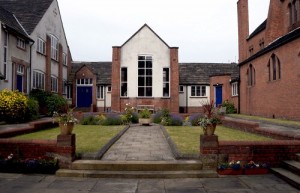

Taken together, the Methodist church, school and garden are finest expression of Edgar Wood’s attempts to synthesize tradition and modernity. These artistic buildings and spaces feel simultaneously both ancient and modern, where the rational and romantic are harmoniously intergrated.
The original Long Street Methodist Sunday School was a unique place of learning for people without weekday education. The design, which used the forms and materials of rural buildings, looked forward to a civilised future where natural beauty and education went together. It was published across Britain, Europe and USA for well over a decade as a progressive school design to be emulated.
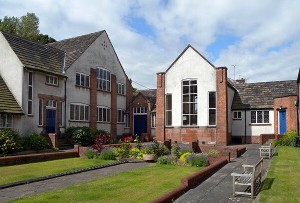
The school comprises a beautiful group of Arts & Crafts buildings set around a garden. Contrasting with the adjacent brick church, the school facade is built in a light lime-washed render with stone and brick art nouveau detailing. The Main School, Infants Schoolroom, Ladies Room (teachers room) and Lecture Room are all individually expressed. However, they are all united with the church under a rustic stone flag roof, one of the biggest traditional roofs in the north of England.
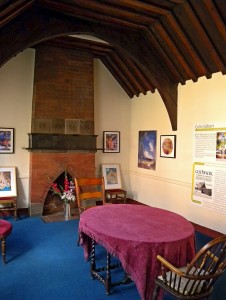
Inside, the focal point of each room is an open roof structure which supports the exceptionally heavy roof. The one in the Lecture Room has king post trusses with plant-like curving struts, an art nouveau touch. The romantic roof over the Ladies Parlour blends perfectly with the art nouveau chimney.
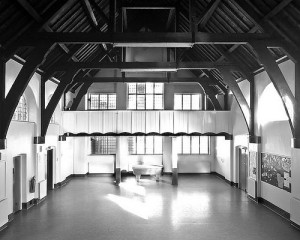
By far the largest space is the School Hall where Edgar Wood installed six spectacular trusses that sit on long curved braces to gain the required width of the hall.
The school is owned by Greater Manchester Building Preservation Trust and supported by a lively group of volunteers who have formed a social enterprise to manage it’s future as a community and heritage facility. Restoration grants gave been submitted to three funding bodies to cover £500,000 of repair work.
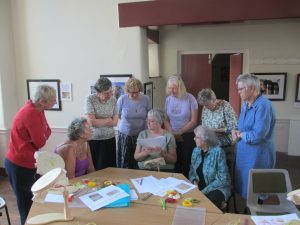
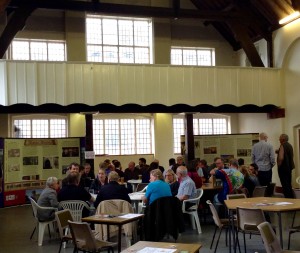
It is believed that Ye Olde Boar’s Head P.H. began life in the 1600s as a pair of clothiers houses on the road between Manchester and Rochdale. At that time, the textile industry was based in houses, where the upper rooms had long rows of windows illuminating the weaving loomshops. The houses were later combined to form an Inn serving travellers between the two towns and in the early 1700s, a Sessions Court house was added which later installed the old fireplace from Middleton Hall when it was demolished.The ‘Old Boar’ itself was almost demolished in the early twentieth century to build a Town Hall but the plan was thwarted by Edgar Wood and the Society for the Protection of Ancient Buildings.
Middleton Archaeological Society is carrying out a study of the building.
Ye Olde Boar’s Head is a wonderfully rambling place. It is a timber framed building of the box-frame type, rare in Greater Manchester and Lancashire. Middleton Archaeological Society are begining a study on the building. The name remembers Middleton’s ancient Lords of the Manor, the Asshetons, who had a boar’s head as the family symbol. Being a pub, you can visit anytime it is open.
Long Street looks lovely in spring with the Jubilee Library cherry blossom out and the trees coming into leaf. This panorama shows how Middleton’s Jubilee Library was designed to respect the timber-framed Old Boar’s Head. The library is an early and unusual Arts & Crafts design and there is only one other listed Arts & Crafts library in England of such an early date.
The official architect was Laurence Booth of Bury who won the competition for designing the library. However, he built nothing like it before or afterwards. Instead, the building is in Edgar Wood’s early Arts & Crafts style (he was aged 29 in 1889).
Edgar Wood’s father and his main client (Schwabe) were the two principal funders of the library and many of the other large funders were also Edgar Wood clients. We think that Laurence Booth was a front to hide Edgar’s involvement as he could not have fairly competed and it would have have been controversial for him to do so. There are many clues in the surviving records that this was the case and that Edgar Wood was indeed the true designer.
In this way, Edgar Wood appears to have designed the town’s first public library creating a state of the art design some ten years before Arts & Crafts architecture began to take off. Consequently, the Library is now firmly on the Edgar Wood heritage trail!
Edgar Wood’s avant garde buildings were very contentious locally and he had to take a very low profile in the design of publicly funded buildings. Similar methods were used to hide his involvement in the design of Long Street Methodist, the Arts & Crafts Church, when he was only revealed as architect at the last minute in December 1898 after all the decisions had been made. Likewise, he was hidden from view in the restoration of the Parish Church and, as one of the leading town planners of England, we also think he was the hidden designer of Alkrington Garden Village. The official designer, Thomas Adams, would have known Edgar as they were both involved in Letchworth Garden City, Hertfordshire.
The Library is full of Arts & Crafts features, like the traditional pegged oak construction used for the timber work (which Mr. Booth complained about!). The reinforced concrete construction of the first floor is another Arts & Crafts experimental feature. Blending traditional handicrafts with modern methods like reinforced concrete were very much Edgar Wood’s approach. Later on, he became famous for his flat concrete roofs and for pioneering modern design.
CLICK HERE to enlarge the photo.
36 Mellalieu Street was Edgar Wood’s first house designed with a concrete flat roof that covered the whole building. It was drawn up in 1906, five years after he had begun experimenting with flat roofs and three years after he had first met J. Henry Sellers and they had begun on their ambitious project to create a new architecture for the new century.
Between 1907 and 1909, Edgar Wood designed similar-looking cubic houses of different sizes and types in Burnley, Heywood, Stafford, Sheffield and Hertfordshire. They were the first modern movement houses in the world and were highly influential.
When 36 Mellalieu Street was built in 1910, Edgar decided to leave off one of the two bay windows he originally planned and to give the detailing a vernacular character. Even so, it was the most modern town house in the country and its cubic form set the style for modern buildings for decades.
36 Mellalieu Street was restored to its original appearance in 2012 as part of the Edgar Wood and Middleton Heritage Initiative.
36 Mellalieu Street is listed Grade II by English Heritage.
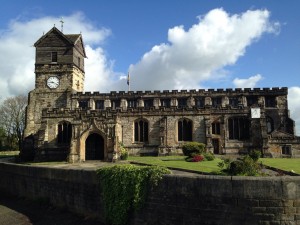 St. Leonard’s or Middleton Parish Church on its hill above the town is by far the oldest building in the area and arguably the oldest in Greater Manchester. It was first established in Saxon times and was a safe haven for the Holy Island monks carrying Lindisfarne Gospels and the coffin of Saint Cuthbert escaping from the marauding Vikings around 880 A.D. The church was rebuilt in Norman times and then again in 1412 by Middleton’s Thomas Langley, Prince Bishop of Durham and Chancellor to Kings Henry IV, V and VI. Bishop Langley somewhat sentimentally retained some of the Norman detailing, notably in the tower arch. In the early 1500s a clerestory was added which lightened the interior. The Reformation shortly afterwards destroyed much of the interior but several medival features survived, including Langley’s rood and parclose screens, misericords and the famous medieval ‘Flodden Window’. After the turmoil of the 1600s, the Geogians added a series of classical monuments in the 1700s but their balconies were all taken out by the Victorians who undertook sensitive alterations. Finally in the twentieth century, Edgar Wood restored the roof, added a boiler house and set the church on a route of sensitive change which involved installing beautiful stained glass and a choir practice room designed by the Arts & Crafts modernist architect George Pace. St. Leonard’s Church is listed Outstanding Grade I by English Heritage
St. Leonard’s or Middleton Parish Church on its hill above the town is by far the oldest building in the area and arguably the oldest in Greater Manchester. It was first established in Saxon times and was a safe haven for the Holy Island monks carrying Lindisfarne Gospels and the coffin of Saint Cuthbert escaping from the marauding Vikings around 880 A.D. The church was rebuilt in Norman times and then again in 1412 by Middleton’s Thomas Langley, Prince Bishop of Durham and Chancellor to Kings Henry IV, V and VI. Bishop Langley somewhat sentimentally retained some of the Norman detailing, notably in the tower arch. In the early 1500s a clerestory was added which lightened the interior. The Reformation shortly afterwards destroyed much of the interior but several medival features survived, including Langley’s rood and parclose screens, misericords and the famous medieval ‘Flodden Window’. After the turmoil of the 1600s, the Geogians added a series of classical monuments in the 1700s but their balconies were all taken out by the Victorians who undertook sensitive alterations. Finally in the twentieth century, Edgar Wood restored the roof, added a boiler house and set the church on a route of sensitive change which involved installing beautiful stained glass and a choir practice room designed by the Arts & Crafts modernist architect George Pace. St. Leonard’s Church is listed Outstanding Grade I by English Heritage